Mike Harrison led a fungus identification walk at Wokefield Common on the morning of Saturday 7 November. Rain was falling gently at the start and at times during the morning there were pulses of heavier rain, but since the walk was through woodland, the weather was not a problem. Wokefield Common is mostly covered by tall pines, with an understorey of oak and birch. There had been prolonged heavy rain in the previous week and Mike commented that too much rain was not good for finding fungi, since they tended to go over more quickly and their colour and scent often washed off. The walk started with a productive inspection of the car park. Mike pointed out a few species which would be seen frequently throughout the walk. One of these was the Conifer Conecap Baeospora myosaura. A number of tiny specimens were growing on a pine cone. Another was Brown Rollrim Paxillus involutus, with a grooved, inrolled margin and ochre-yellow gills extending down the stem. The car park specimen was past its best and was infected with Bolete Mould Hypomyces chrysospermus. Individual bays within the car park were marked out with conifer logs and one of these had a patch of the small orange jelly-like spots of Common Jelly Spot Dacrymyces stillatus. There were a number of specimens of Wood Blewit Lepista nuda. The younger and fresher specimens were purple, while the older ones had turned brown. Earpick Fungus Auriscalpium vulgare was another species which was found growing on a pine cone. It is a small fungus with a long stem and spines on the underside of the cap. Milkcaps were seen throughout the walk. In the car park was a specimen of Liver Milkcap Lactarius hepaticus which is associated with pine trees. Mike bravely tasted a drop of the exuded milk – it was initially mild, then hot and acrid. A drop of milk on a tissue slowly turned from white to yellow. A Bay Bolete Boletus badius had a shiny dark brown, hemispheric cap. There was a very old specimen of Dyer’s Mazegill Phaeolus schweinitzii, then Tawny Funnel Lepista flaccida was found under an oak. It had crowded gills which extended down the stem. Common Rustgill Gymnopilus penetrans was growing on rotten conifer wood, while Oakbug Milkcap Lactarius quietus was found under oak. Mike demonstrated that the long slender stem of Snapping Bonnet Mycena vitilis made a snapping sound when broken. Like all the other Brittlegills Russula sp. found on the walk, a specimen with the hint of a formerly reddish purple cap was too washed-out to identify with certainty. A tuft of Clustered Brittlestem Psathyrella multipedata was found and there were specimens of Common Bonnet Mycena galericulata with transverse ribs between the gills.
After crossing two roads, the walk continued in the northern section of Wokefield Common. A clump of Velvet Rollrim Tapinella atrotomentosa was growing on a stump in a grassy clearing. It was a big brown gill fungus which had an eccentric stem with black hairs at its base. Candlesnuff Xylaria hypoxylon and Yellow Stagshorn Calocera viscosa were seen on mossy stumps and False Chanterelle Hygrophoropsis aurantiaca was found amongst pine litter. Unlike the true Chanterelle Cantharellus cibarius, it had a definite cap. A young specimen of Tawny Grisette Amanita fulva had an almost cylindrical cap and was growing out of the bag-like vulva, while an older specimen had a convex cap with a characteristic grooved margin. The stem of Milking Bonnet Mycena galopus exuded a white juice when broken. A small white gill fungus on a fallen branch was one of the Oysterlings Crepidotus sp. A yellow slime mould was found at the side of the path. Part of it was on a pine cone which was fused to a dead branch. The branched network of the streaming plasmodium could be seen as well as the yellow mass of the immature fruiting bodies. Mike thought that it was probably Leocarpus fragilis, but it was still too immature to confirm by microscopy. The path went past the edge of a small pond. On a wood pile next to the pond were fragments of green cut stems, all that was left of Saffron Milkcap Lactarius deliciosus after someone had foraged the main fruiting body. On the ground on the other side of the path was a line of 12 distinctively twisted specimens of White Saddle Helvella crispa. The next find was Purplepore Bracket Trichaptum abietinum. Then there was an Ugly Milkcap Lactarius turpis – it was an old specimen of a large milkcap with a dark cap and hot-tasting milk. Under an oak tree were a number of Sulphur Knight Tricholoma sulphureum fungi. These are normally yellow with a distinctive sulphur smell, but they had been washed out to white by the rain and the smell had also been washed away. A Blusher Amanita rubescens was another washed-out specimen. It still had a ring but no scales were left on its cap. Its flesh turned red when bruised. Many of the group learned a new word, ‘merulioid’, which Mike used to describe Leucogyrophana mollusca, which had wrinkled folds, rather than gills or pores, on its underside. Tiny grey-blue specimens of Mycena pseudocorticola were spotted on the mossy trunk of an oak. Lower down, there were some even smaller pink and white specimens. The path led through a slightly more open section where, somewhat surprisingly, Heather Calluna vulgaris was just coming into flower. The next find was Rufous Milkcap Lactarius rufus, a brown, leathery fungus with reddish, crowded, decurrent gills. The early stage of Postia ptychogaster, looking like a spiky sponge, was found on rotting conifer wood. It will later go on to produce a bracket. Pale green cup-like fruiting bodies of a Cladonia lichen were found at the base of a pine, while nearby were Oak Moss Lichen Evernia prunastri, which was green above and white below, and the lichen Punctelia jeckeri. A clump of Clustered Bonnet Mycena inclinata was found on oak. Then there was a group of yellow Sulphur Tuft Hypholoma fasciculare on a stump. A Scaly Earthball Scleroderma verrucosum had a noticeable root. Next find was a Common Puffball Lycoperdon perlatum. Birch Milkcap Lactarius tabidus was another species whose milk gradually turned from white to yellow when dropped onto a tissue. Another slime mould, this time orange rather than yellow, was found and a sample was taken away for investigation under a microscope. The next find was Yellowleg Bonnet Mycena epipterygia on dead wood. It had a green stem and was exceedingly slimy. Heading back towards the start, Turkeytail Trametes versicolor, Bleeding Oak Crust Stereum gausapatum, Deer Shield Pluteus cervinus and Butter Cap Rhodocollybia butyracea were amongst the sightings. Netted Crust Byssomerulius corium was another merulioid fungus. Finally, there were a few more finds back in the car park. The tiny Orange Bonnet Mycena acicula was growing on a conifer log and Pale Stagshorn Calocera pallidospathulata was found on another log. It was first recorded in Britain in 1969 and initially spread slowly, with few records before 1990. But since then its spread has accelerated and it is now almost as common as the other two stagshorn species.
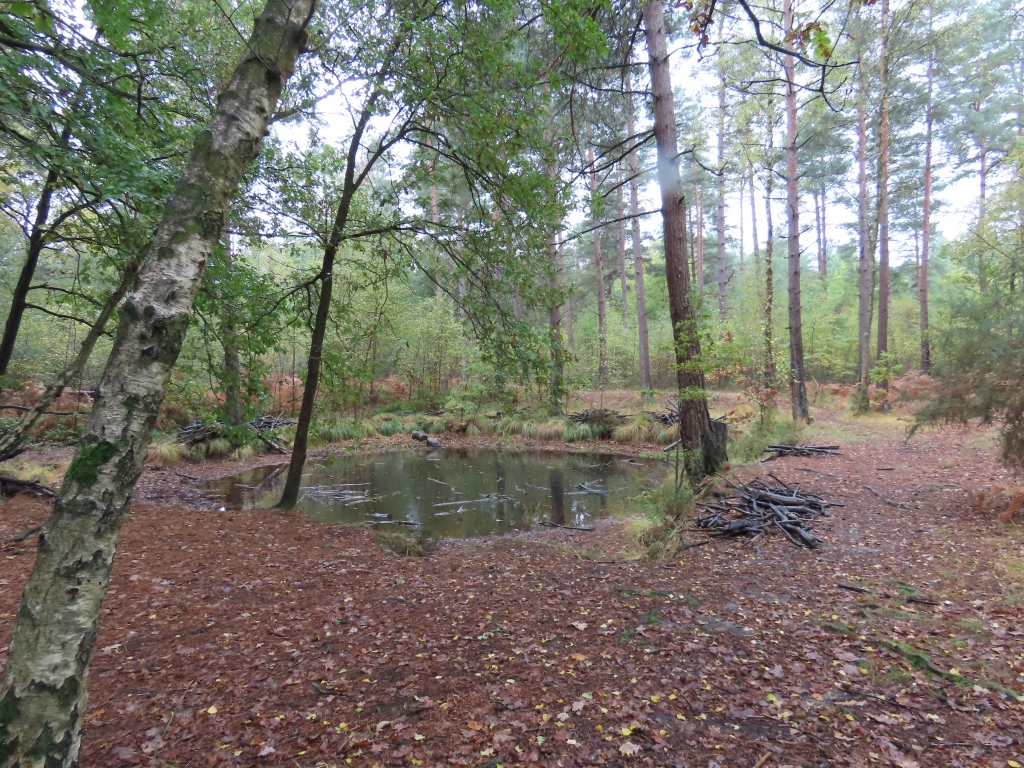
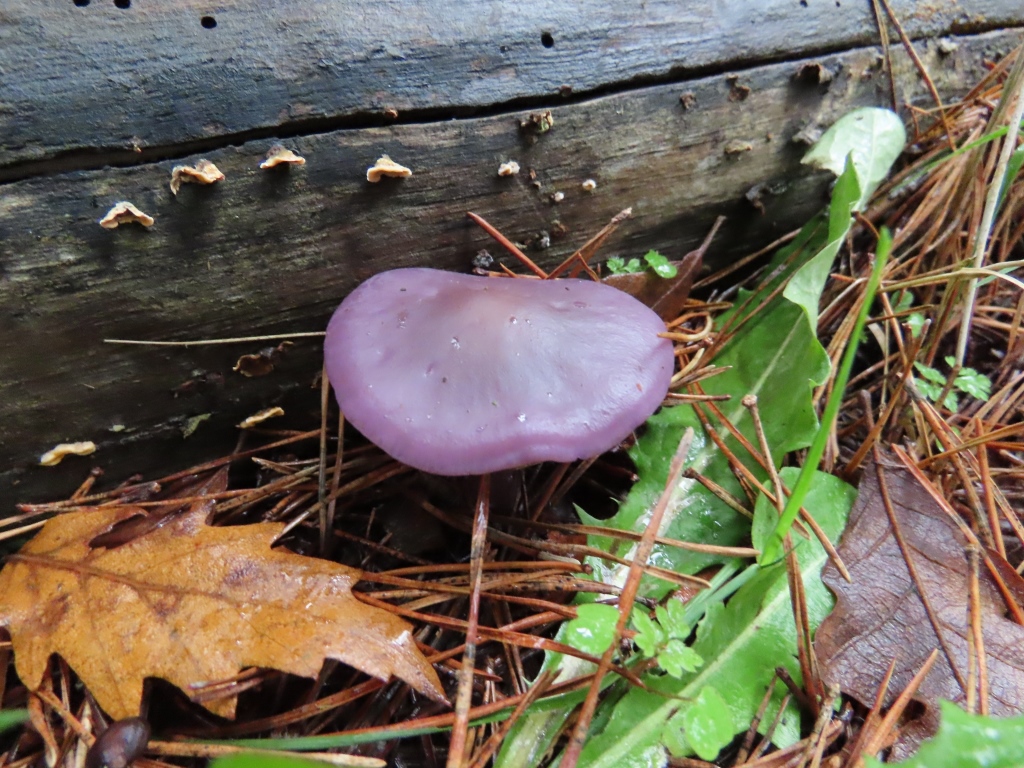
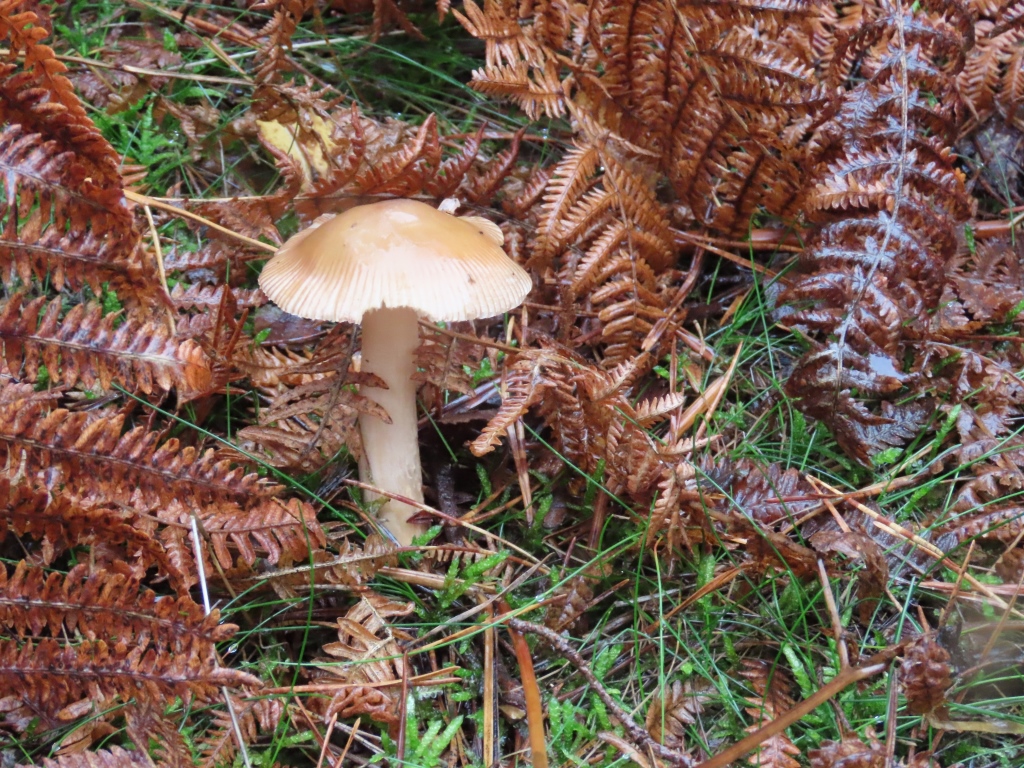
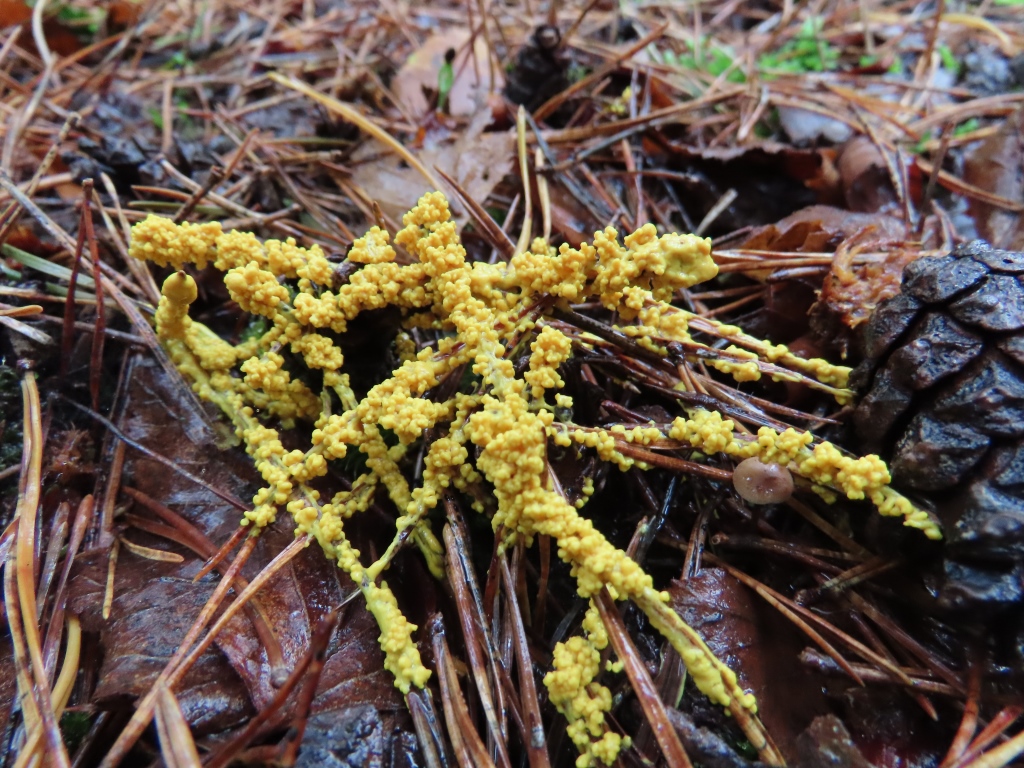
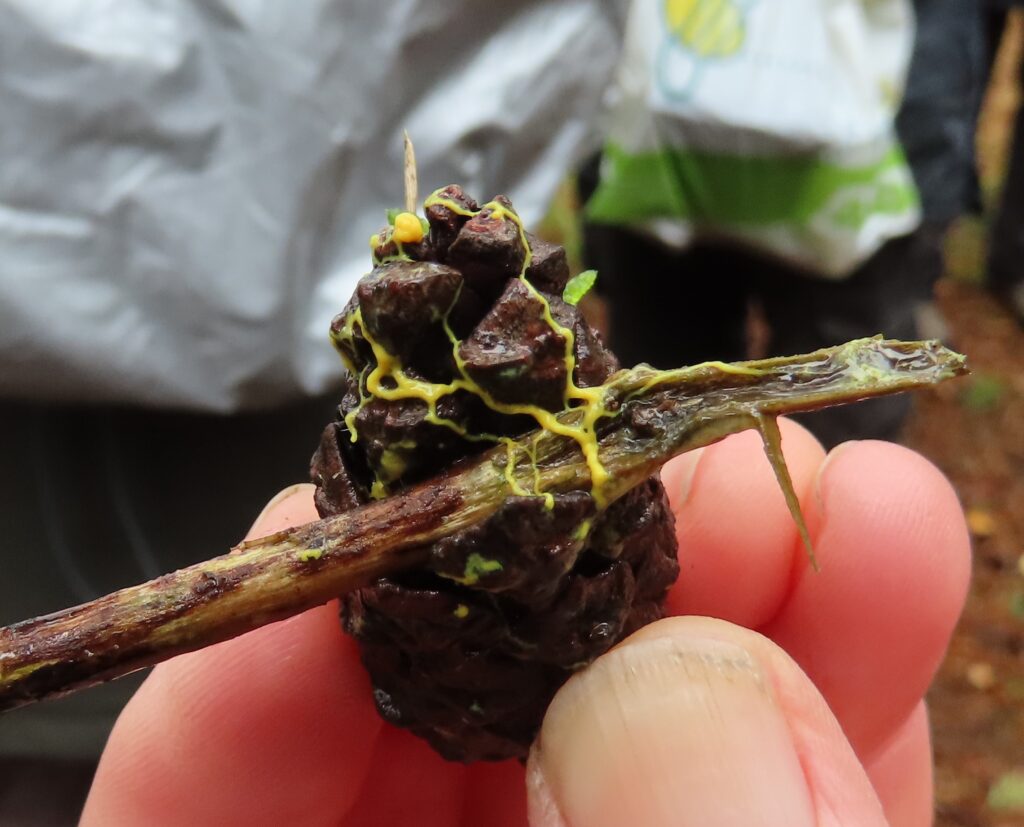
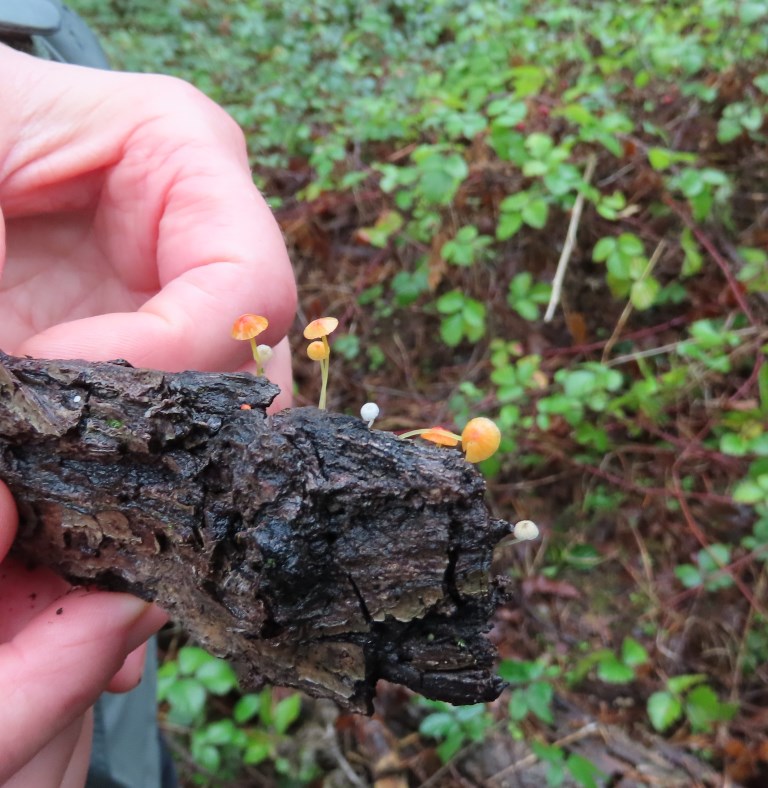
Pictures by Fiona Brown
| Formal Name | Common Name | Comments |
| Amanita fulva | Tawny Grisette | |
| Amanita rubescens | Blusher | |
| Auriscalpium vulgare | Earpick Fungus | On pine cone |
| Baeospora myosura | Conifer Cone Cap | Pine cones |
| Boletus badius | Bay Bolete | |
| Byssomerulius corium | Netted Crust | |
| Calocera pallidospathulata | Pale Stagshorn | |
| Calocera viscosa | Yellow Stagshorn | |
| Coniophora puteana | Wet Rot | |
| Crepidotus sp | Oysterling | |
| Dacrymyces stillatus | Orange Jellyspot | |
| Gymnopilus penetrans | Common Rustgill | |
| Helvella crispa | White Saddle | |
| Hygrophoropsis aurantiaca | False Chanterelle | |
| Hypholoma fasciculare | Sulphur Tuft | |
| Lactarius deliciosus | Saffron Milkcap | cut stem bases |
| Lactarius hepaticus | Liver Milkcap | |
| Lactarius quietus | Oakbug Milkcap | |
| Lactarius rufus | Rufous Milkcap | |
| Lactarius tabidus | Birch Milkcap | |
| Lactarius turpis | Ugly Milkcap | |
| Lepista flaccida | Tawny Funnel | |
| Lepista nuda | Wood Blewit | |
| Leucogyrophana mollusca | n/a | |
| Lycoperdon perlatum | Common Puffball | |
| Mycena acicula | Orange Bonnet | |
| Mycena epipterygia | Yellowleg Bonnet | |
| Mycena galericulata | Common Bonnet | |
| Mycena galopus | Milking Bonnet | |
| Mycena inclinata | Clustered Bonnet | |
| Mycena pseudocorticola | n/a | on mossy trunk |
| Mycena vitilis | Snapping Bonnet | |
| Paxillus involutus | Brown Rollrim | |
| Phaeolus schweinitzii | Dyer’s Mazegill | |
| Pluteus cervinus | Deer Shield | |
| Postia caesia | Conifer Blueing Bracket | car park logs |
| Postia ptychogaster | Powderpuff Bracket | imperfect stage |
| Postia stiptica | Bitter Bracket | |
| Psathyrella multipedata | Clustered Brittlestem | |
| Rhodocollybia butyracea | Buttercap | |
| Russula fragilis | Fragile Brittlegill | |
| Scleroderma verrucosum | Scaly Earthball | |
| Stereum gausapatum | Bleeding Oak Crust | |
| Stereum hirsutum | Hairy Curtain Crust | |
| Tapinella atrotomentosa | Velvet Rollrim | big yellow brackets on pine stumps |
| Trametes versicolor | Turkeytail | |
| Trichaptum abietinum | Purple Porebracket | |
| Tricholoma sulphureum | Sulphur Knight | |
| Xylaria hypoxylon | Candlesnuff | |
| Phyllonorycter maestingella | Beech leaf miner | mines on beech |
| Trochulus hispidus | Hairy Snail | non-hairy C |
| Leocarpus fragilis | n/a | conifer, birch litter |
